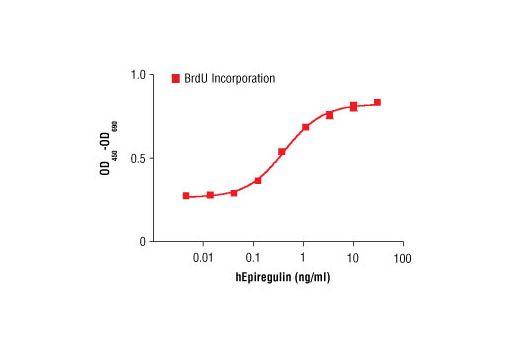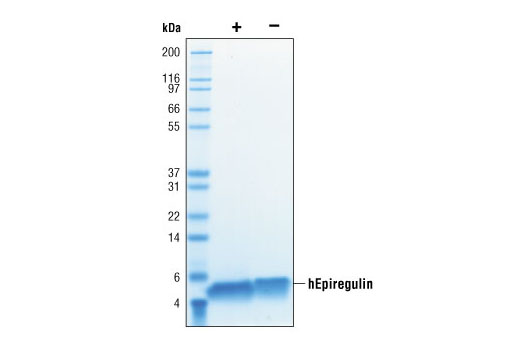5
#O14944
2069
Background
Epiregulin is a member of the EGF family that is highly expressed in many cancer-specific cells, cells of the placenta and macrophages (1,2). Epiregulin induces keratinocyte and corneal epithelial cell proliferation, oocyte maturation and may function in blastocyst implantation during pregnancy (3-5). Active soluble epiregulin is produced by proteolytic processing of a transmembrane precursor. Epiregulin is the only EGF family member known to bind to both the ErbB1/HER1 and ErbB4/HER4 EGF receptors (6). Epiregulin binding induces receptor homodimerization or heterodimerization with other Erb/Her receptors. Epiregulin activates the ERK1/2, and PI3K/Akt pathways (1,3).
- Toyoda, H. et al. (1997) Biochem J 326 ( Pt 1), 69-75.
- Révillion, F. et al. (2008) Ann Oncol 19, 73-80.
- Morita, S. et al. (2007) Mol Vis 13, 2119-28.
- Shirakata, Y. et al. (2000) J Biol Chem 275, 5748-53.
- Song, H. et al. (2000) Mol Endocrinol 14, 1147-61.
- Riese, D.J. et al. (1998) J Biol Chem 273, 11288-94.
Endotoxin
Less than 0.01 ng endotoxin/1 μg hEpiregulin.
Purity
>98% as determined by SDS-PAGE of 6 μg reduced (+) and non-reduced (-) recombinant hEpiregulin. All lots are greater than 98% pure.
Source / Purification
Recombinant human Epiregulin (hEpiregulin) Val63-Leu108 (Accession #NP_001423) was produced in E. coli at Cell Signaling Technology.
Bioactivity
The bioactivity of recombinant hEpiregulin was determined in a MCF 10A cell proliferation assay. The ED50 of each lot is between 0.10-0.85 ng/ml.
Background
Epiregulin is a member of the EGF family that is highly expressed in many cancer-specific cells, cells of the placenta and macrophages (1,2). Epiregulin induces keratinocyte and corneal epithelial cell proliferation, oocyte maturation and may function in blastocyst implantation during pregnancy (3-5). Active soluble epiregulin is produced by proteolytic processing of a transmembrane precursor. Epiregulin is the only EGF family member known to bind to both the ErbB1/HER1 and ErbB4/HER4 EGF receptors (6). Epiregulin binding induces receptor homodimerization or heterodimerization with other Erb/Her receptors. Epiregulin activates the ERK1/2, and PI3K/Akt pathways (1,3).
Background References
Cross-Reactivity Key
H: human M: mouse R: rat Hm: hamster Mk: monkey Vir: virus Mi: mink C: chicken Dm: D. melanogaster X: Xenopus Z: zebrafish B: bovine Dg: dog Pg: pig Sc: S. cerevisiae Ce: C. elegans Hr: horse GP: Guinea Pig Rab: rabbit All: all species expected
Trademarks and Patents
Limited Uses
Except as otherwise expressly agreed in a writing signed by a legally authorized representative of CST, the following terms apply to Products provided by CST, its affiliates or its distributors. Any Customer's terms and conditions that are in addition to, or different from, those contained herein, unless separately accepted in writing by a legally authorized representative of CST, are rejected and are of no force or effect.
Products are labeled with For Research Use Only or a similar labeling statement and have not been approved, cleared, or licensed by the FDA or other regulatory foreign or domestic entity, for any purpose. Customer shall not use any Product for any diagnostic or therapeutic purpose, or otherwise in any manner that conflicts with its labeling statement. Products sold or licensed by CST are provided for Customer as the end-user and solely for research and development uses. Any use of Product for diagnostic, prophylactic or therapeutic purposes, or any purchase of Product for resale (alone or as a component) or other commercial purpose, requires a separate license from CST. Customer shall (a) not sell, license, loan, donate or otherwise transfer or make available any Product to any third party, whether alone or in combination with other materials, or use the Products to manufacture any commercial products, (b) not copy, modify, reverse engineer, decompile, disassemble or otherwise attempt to discover the underlying structure or technology of the Products, or use the Products for the purpose of developing any products or services that would compete with CST products or services, (c) not alter or remove from the Products any trademarks, trade names, logos, patent or copyright notices or markings, (d) use the Products solely in accordance with CST Product Terms of Sale and any applicable documentation, and (e) comply with any license, terms of service or similar agreement with respect to any third party products or services used by Customer in connection with the Products.


